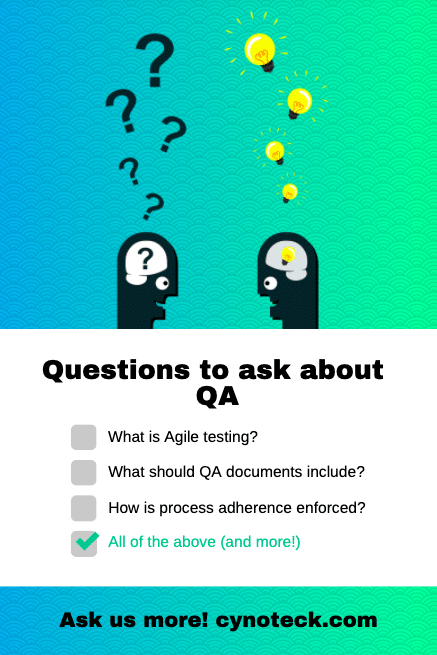11 Questions on QA and testing to Ask Your App Development Partner


Software quality assurance (QA) is a process done to ensure the quality of the production of the software. Testing ensures the final software product's quality. Both are of high importance in the development of a superior software product. As outsourcing app development becomes more and more popular, you will want to make sure you are achieving the highest quality software product possible, even if you cannot physically be there with the developers.
Listed are 11 questions you should ask your development partner regarding these topics. They can be used as QA interview questions or even as questions to be posed once you’ve chosen your app development partner and are beginning a project.

Agile methodology conducts the testing throughout the development process, not just at the end. It requires communication between you, possibly the customer, and the development partner.
It is useful for complex projects that may have changes to the requirements during the software development process.
Like the name suggests, Agile gives you and the development team some flexibility and allows for a better product to be produced.
These are all various means of testing software. Branch testing tests all possible branches of code, and boundary testing focuses on the most extreme limits of the software.
Also known as behavioral testing, black box testing is done without the knowledge of the internal structure of the software. On the other hand, white box testing is done when the code is visible to the tester.
QA documents are used in the management and delivery of software. They vary from standard operating procedures (SOPs) of the software to quality manuals that list all the defects with their respective severity levels.
They can also include all the business requirements with explanations of each one. Configurations, user and manager reports, and lists of test cases can also be included in QA documentation.
It is generally best to have more documentation than less, so make sure you ask your app development partner about which documents they will include in your project’s quality assurance.
Once the software is validated through rigorous testing, it must be verified. One of the best ways to conduct validation activities is through third parties that you can hire to provide verification of the project.
Other effective methods include assigning employees to this process. Find out how your app development partner plans to carry out this process, and don’t hesitate to ask them more about it.
During the development of software, you may encounter these terms, which can be easily confused since they are quite similar.
In order to better understand what your development partner may be saying to you and create better communication, it is important to understand the difference between them.
A build is a number that is given by the development team to the testing team that represents a version of the software.
A release is the number that is given to you from the app's testing or development team.
To ensure the success of the software from all angles, it is important to test it with various methods, such as those mentioned in an earlier point.
Simply using one method of testing will decrease time spent on the software and could save you money, but you will not receive a quality product.
Make sure to ask that the developer plans to use multiple methods when building the software, as well as in the final product.
Configuration management is essentially the process of recording and documenting all changes that occur to the software development process. Subsets of this include release control and revision control.
Negative testing is when undesired inputs and user behaviour of the software are tested.
In regard to your specific software solution, what checkpoints will be set to make sure that the product is being developed up to the right standards? A sub-question is, how will these checkpoints occur?
How do the developers plan to stick to a proper plan to ensure quality? Their answer could be through product evaluation and process monitoring?
A cause-and-effect graph is a testing technique originally used in hardware testing and later adapted for software testing. This method, known as CEG, falls under the category of black-box testing, focusing solely on the intended external behavior of a system. The process involves identifying causes, effects, and constraints outlined in the natural language specifications during the CEG analysis.
As we close the chapter on delving into the essential QA and testing questions for your app development partner, it’s evident that these inquiries aren’t just checkboxes but the Sherlock Holmes magnifying glass for your project’s success. They’re not just random questions; they’re the secret codes that unlock the door to a smoother, bug-free app experience.
In my journey as a QA consultant, I’ve realized the gravity of these questions. They’re not mere conversation starters; they’re the blueprint that assures the quality and reliability of your app. They’re the foundation upon which trust and confidence in your app’s performance are built.
These questions aren’t just a formality; they’re the risk mitigators that shield your app from potential pitfalls and ensure a seamless user experience. They’re the assurance that your app development partner isn’t just a developer, but a partner invested in the success of your project.
So, the main takeaway? These questions aren’t just words on paper; they’re the rudder that steers your app development voyage. They’re the compass that ensures your app sails smoothly in the sea of fierce market competition. Here’s to asking the right questions and crafting the path to a high-quality, glitch-free app experience!
We are more than just developers and consultants—we are your partners in navigating the digital landscape. Let us be the engine behind your next big success while you focus on your core vision.
Explore Opportunities!